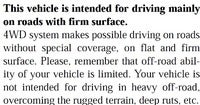jaapv
Well-known member
Are you sure there is no diff-lock effect? According to Mitsubshi 4WDlock delivers equal power to each of the wheels, which, if true, has the same effect as diff locks.
A low ratio transfer box is superfluous, as electric motors deliver full torque from standstill. For the ret I quite agree.
A low ratio transfer box is superfluous, as electric motors deliver full torque from standstill. For the ret I quite agree.
maby said:I think there are several aspects to a car's off-road abilities - and I have owned many Landrovers and a smaller number of Landcruisers. The Outlander should be fine for relatively slow transits of muddy and moderately uneven ground, but it lacks several of the important features of a genuine off-roader.
The biggest is probably clearance and axle articulation. Landrover used to put a Defender LWB on display outside each showroom perched on two concrete blocks each getting on for a metre high - one under the nearside front wheel and the other under the offside rear wheel - try doing that with an Outlander! The ability to cross-articulate is important - particularly if the transmission is not genuine off-road.
The lack of a low ratio transfer box and differential locks will also be a problem - that 4WD button presumably pretends to be a centre diff-lock, but there are no locks on the front and rear axle diffs. With the lack of cross-articulation that I expect it to have, the lack of those diff-locks could leave you in trouble.
The other problem is sheer physical strength. Landrovers and Landcruisers have ladder chassis built out of girders with suspension attached that would not be out of place on a small lorry (I've done major work on Landrover suspension and you are using sledge hammers as often as screwdrivers). A Landrover will survive being driven fast across a ploughed field for miles - with the suspension on an Outlander, I certainly would not try driving my £35k car at anything more than walking pace - I don't want to break it.
None of that necessarily matters - I'm loving the car - but my days of real off-roading are long over. I've driven a Landrover up goat tracks and parked on mountain tops - makes for a great view while you cook your breakfast in the back - but I'll not be trying it on the Outlander!

